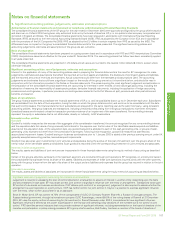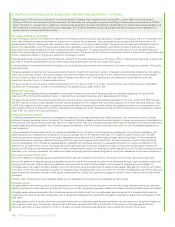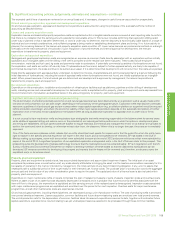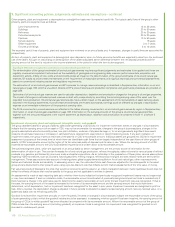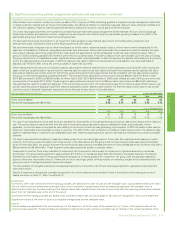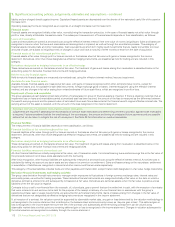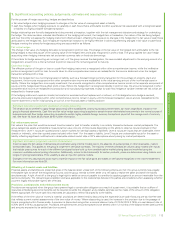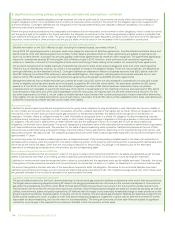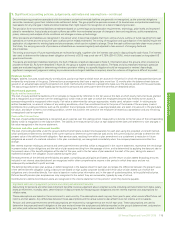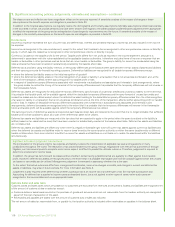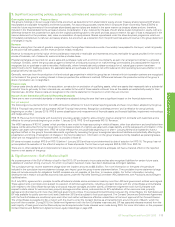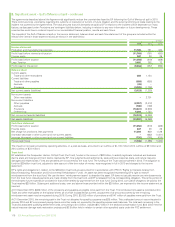BP 2015 Annual Report Download - page 112
Download and view the complete annual report
Please find page 112 of the 2015 BP annual report below. You can navigate through the pages in the report by either clicking on the pages listed below, or by using the keyword search tool below to find specific information within the annual report.
1. Significant accounting policies, judgements, estimates and assumptions – continued
Rosneft since 2013 and he is a member of the Rosneft board’s Strategic Planning Committee. During 2015, a second BP-nominated director,
Guillermo Quintero, was elected to the Rosneft board. BP also holds the voting rights at general meetings of shareholders conferred by its 19.75%
stake in Rosneft. In management’s judgement, the group has significant influence over Rosneft, as defined by the relevant accounting standard, and
the investment is, therefore, accounted for as an associate. BP’s share of Rosneft’s oil and natural gas reserves is included in the estimated net
proved reserves of equity-accounted entities.
The equity method of accounting
Under the equity method, the investment is carried on the balance sheet at cost plus post-acquisition changes in the group’s share of net assets of the
entity, less distributions received and less any impairment in value of the investment. Loans advanced to equity-accounted entities that have the
characteristics of equity financing are also included in the investment on the group balance sheet. The group income statement reflects the group’s
share of the results after tax of the equity-accounted entity, adjusted to account for depreciation, amortization and any impairment of the equity-
accounted entity’s assets based on their fair values at the date of acquisition. The group statement of comprehensive income includes the group’s
share of the equity-accounted entity’s other comprehensive income. The group’s share of amounts recognized directly in equity by an equity-accounted
entity is recognized directly in the group’s statement of changes in equity.
Financial statements of equity-accounted entities are prepared for the same reporting year as the group. Where material differences arise, adjustments
are made to those financial statements to bring the accounting policies used into line with those of the group.
Unrealized gains on transactions between the group and its equity-accounted entities are eliminated to the extent of the group’s interest in the equity-
accounted entity.
The group assesses investments in equity-accounted entities for impairment whenever events or changes in circumstances indicate that the carrying
value may not be recoverable. If any such indication of impairment exists, the carrying amount of the investment is compared with its recoverable
amount, being the higher of its fair value less costs of disposal and value in use. If the carrying amount exceeds the recoverable amount, the
investment is written down to its recoverable amount.
The group ceases to use the equity method of accounting from the date on which it no longer has joint control over the joint venture or significant
influence over the associate, or when the interest becomes classified as an asset held for sale.
Segmental reporting
The group’s operating segments are established on the basis of those components of the group that are evaluated regularly by the group chief
executive, BP’s chief operating decision maker, in deciding how to allocate resources and in assessing performance.
The accounting policies of the operating segments are the same as the group’s accounting policies described in this note, except that IFRS requires
that the measure of profit or loss disclosed for each operating segment is the measure that is provided regularly to the chief operating decision maker.
For BP, this measure of profit or loss is replacement cost profit before interest and tax which reflects the replacement cost of inventories sold in the
period and is arrived at by excluding inventory holding gains and losses from profit. Replacement cost profit for the group is not a recognized measure
under IFRS. For further information see Note 5.
Foreign currency translation
In individual subsidiaries, joint ventures and associates, transactions in foreign currencies are initially recorded in the functional currency of those
entities at the spot exchange rate on the date of the transaction. Monetary assets and liabilities denominated in foreign currencies are retranslatedinto
the functional currency at the spot exchange rate on the balance sheet date. Any resulting exchange differences are included in the income statement,
unless hedge accounting is applied. Non-monetary assets and liabilities, other than those measured at fair value, are not retranslated subsequent to
initial recognition.
In the consolidated financial statements, the assets and liabilities of non-US dollar functional currency subsidiaries, joint ventures, associates, and
related goodwill, are translated into US dollars at the spot exchange rate on the balance sheet date. The results and cash flows of non-US dollar
functional currency subsidiaries, joint ventures and associates are translated into US dollars using average rates of exchange. In the consolidated
financial statements, exchange adjustments arising when the opening net assets and the profits for the year retained by non-US dollar functional
currency subsidiaries, joint ventures and associates are translated into US dollars are taken to a separate component of equity and reported in the
statement of comprehensive income. Exchange gains and losses arising on long-term intra-group foreign currency borrowings used to finance the
group’s non-US dollar investments are also taken to other comprehensive income. On disposal or partial disposal of a non-US dollar functional currency
subsidiary, joint venture or associate, the related cumulative exchange gains and losses recognized in equity are reclassified to the income statement.
Non-current assets held for sale
Non-current assets and disposal groups classified as held for sale are measured at the lower of carrying amount and fair value less costs to sell.
Non-current assets and disposal groups are classified as held for sale if their carrying amounts will be recovered through a sale transaction rather than
through continuing use. This condition is regarded as met only when the sale is highly probable and the asset or disposal group is available for
immediate sale in its present condition subject only to terms that are usual and customary for sales of such assets. Management must be committed
to the sale, which should be expected to qualify for recognition as a completed sale within one year from the date of classification as held for sale, and
actions required to complete the plan of sale should indicate that it is unlikely that significant changes to the plan will be made or that the plan will be
withdrawn.
Property, plant and equipment and intangible assets are not depreciated or amortized once classified as held for sale.
Intangible assets
Intangible assets, other than goodwill, include expenditure on the exploration for and evaluation of oil and natural gas resources, computer software,
patents, licences and trademarks and are stated at the amount initially recognized, less accumulated amortization and accumulated impairment losses.
Intangible assets acquired separately from a business are carried initially at cost. An intangible asset acquired as part of a business combination is
measured at fair value at the date of acquisition and is recognized separately from goodwill if the asset is separable or arises from contractual or other
legal rights.
Intangible assets with a finite life, other than capitalized exploration and appraisal costs as described below, are amortized on a straight-line basis over
their expected useful lives. For patents, licences and trademarks, expected useful life is the shorter of the duration of the legal agreement and
economic useful life, and can range from three to 15 years. Computer software costs generally have a useful life of three to five years.
108 BP Annual Report and Form 20-F 2015











